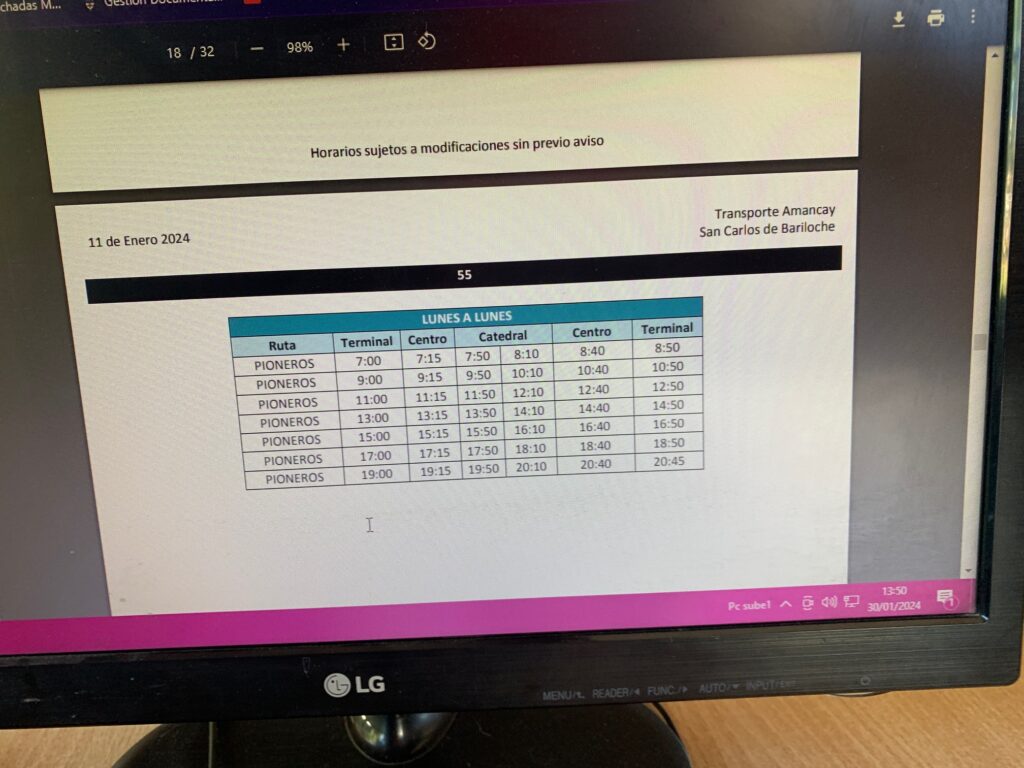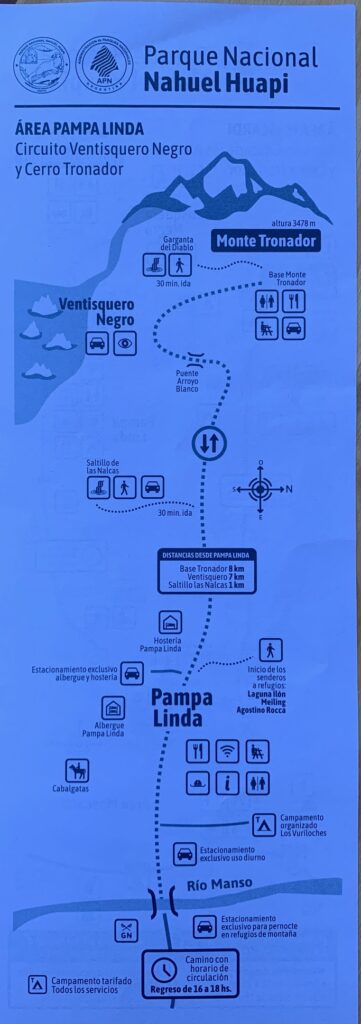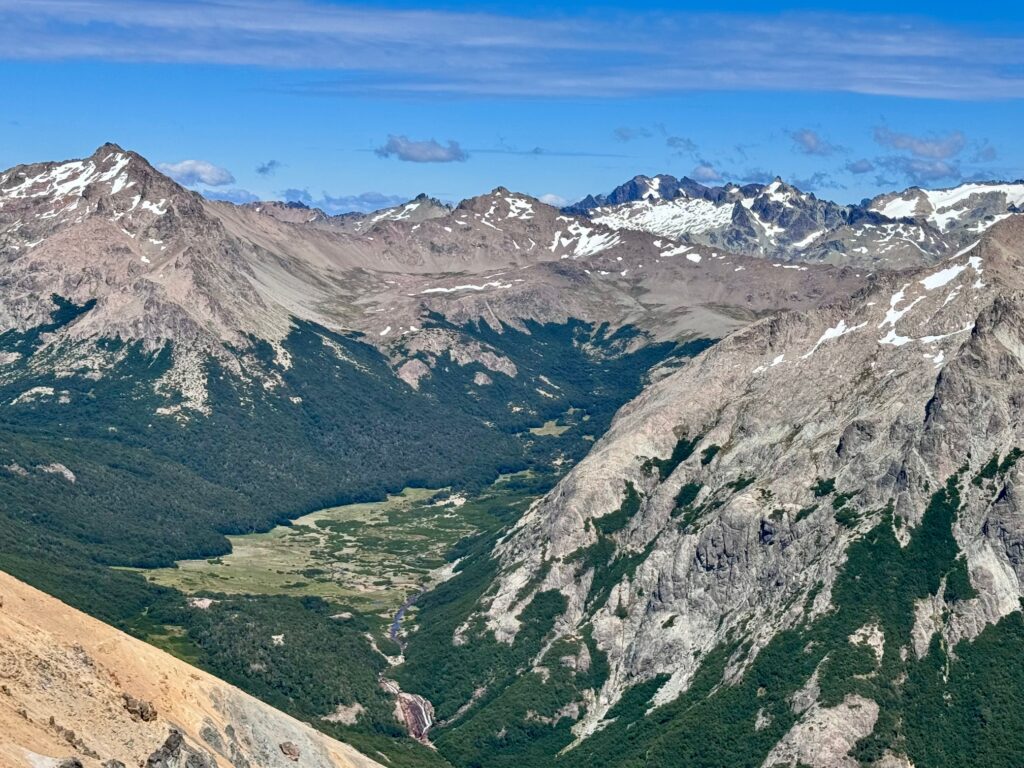On top of Cerro Catedral reachable by teleferico (cable car). The base of Cerro Catedral is a short 30 minute bus ride from Bariloche.
Highlights
Bariloche is one of the popular destinations in Argentina. Another place to visit but less known is San Martin de los Andes. Between the two towns is the scenic Siete Lagos (seven lakes) drive on Ruta 40.
This area of Argentina is considered the northern end of Patagonia. The elevation of Bariloche is around 3,000 feet above sea level while San Martin is around 2,000 feet. Though not very high in elevation, the weather here feels like it is much higher because of its latitude.
The area is blessed with mountains and crystal clear alpine lakes. The mountains look similar to Colorado, USA. The base of the mountains are verdant green while the top of the mountains have exposed rocks as it is above the tree line.
Time of Visit: January 2024
Duration of Visit: Two nights at San Martin de los Andes and four nights at Bariloche.
Bariloche


The City
The city is of decent size. The city center is very walkable but you will need a mode of transportation to reach other places including nearby communities that act as suburbs. Bariloche’s main street is Mitre Street. Shops line this street and are just filled with people milling around.
Mitre Street is the equivalent of Florida Street in Buenos Aires. Here you will hear some people calling “cambio, cambio”. Just go to Mitre Street if you need your USD converted to ARS.
Bus System
You need a SUBE bus card to use the bus system. However, you cannot buy the bus card from the bus driver. The bus driver is not supposed to accept cash payments. We got our SUBE bus card at the tourist information office right in front of the plaza on Liberta Street (on Google Maps it is labeled as Centro Civico Bariloche).
The card costs 880 ARS. A local bus ride cost 270 ARS while the bus going to Cerro Catedral costs 800 ARS. You can load the SUBE card at any store that has the SUBE sign. We loaded ours at the Area 21 store near the corner of Mitre Street and Urquiza Street.
How to Get to Town From the Airport
We saw a bus that takes visitors to town. This is probably the cheapest way. Uber is available at Bariloche and is cheaper than taking a taxi. However, you may have to wait at least 10 minutes as they do not normally wait at the airport’s pay parking area (meaning they may have to come from the city which is a few miles away).
There are taxis just outside the airport’s main door. They have meters so there is no need to haggle. We found that taxis cost more than an Uber ride. We had to take a taxi as we were running late in picking up our rental car in town (there are rental cars at the airport but it was cheaper in town). The taxi ride costs us close to 11K ARS.
What To Do In Bariloche
There are a myriad of outdoor activities around Bariloche. Lago (lake) Nahuel Huapi is huge and is right in town. The lake is cold and we did not see anybody in the water. However, there were plenty of people sitting on the pebbly lakeshore and just enjoying the wind and the sun on their faces.
If you get tired of sunning yourself at the beach, you can walk on Mitre street and pick an excursion to your liking. There are numerous stalls that offer excursions ranging from tours to river rafting.




Hiking on the mountain top at Cerro Catedral is another way to spend the day. One popular hike is Rifugio Frey but it takes 4 to 5 hours one way if you start at the base of the mountain. Best to make overnight reservations at the rifugio so you are not in a hurry to get back down. If you are doing a long trek, such as Rifugio Frey, it is mandatory to register or else you may get fined. Registration can be done on-line on the Parque National Nahuel Huapi’s website. The trick is to know which part of the park you are hiking and the destination’s name.
There is a teleferico (cable car) that takes visitors up to Cerro Catedral. The ride was 20K ARS per person. There is a trail from the mountain top that goes to Rifugio Frey. However, it takes about 4 hours to complete the roughly 9 kilometers of trail that goes mainly over the rocky mountain top.
Bus 55P takes visitors from Bariloche’s city center to the base of Cerro Castillo or alpine village. The bus runs every two hours and takes Pioneros Street on its way to the alpine village. Google Maps shows Bus 55B (B for Bustillo Street) as also going to the alpine village but that bus never came when it was supposed to.




Eating ice cream at Mamuschka is another local favorite. If you like beer, then you have come to the right town as Bariloche is a craft beer hub in Argentina. If you have a sweet tooth, then Bariloche will fill that desire with its several chocolate stores as the town is known as Argentina’s chocolate capital.
Abundance of Speed Cameras
Bariloche and its surrounding towns have an abundance of speed cameras. You need to pay attention to your speed and the warning signs or you may get a surprise bill from the rental car agency.
Cerro Tronador
Cerro Tronador is inside the Parque Nacional Nahuel Huapi. It took us a couple of hours to drive to the park entrance from Bariloche, including about 30 minutes of stopping at a couple of inviting lakes to take photos. We paid 6,500 ARS per person to enter the park.
The drive to the base of Cerro Tronador from Ruta 40 is about 50 kilometers of dirt road. We had a Renault Logan which is about the same size as a Toyota Corolla and did not have any problems with the rough road.




The first nine kilometers past the park entrance are open to two way traffic. At the 9th kilometer, visitors can either continue straight to Cascada Los Alerces or turn right to head over to the base of Cerro Tronador. We did not have time during our trip to drive to Cascada Los Alerces (so make sure you get to the park early unlike us).
Along the way, you will pass by Mirador Lago Mascardi, the trailhead to Cascada Los Cesares and Hosteria Pampa Linda. Mirador Lago Mascardi offers a nice panoramic lake view and is worth a short stop to take photos. We did not have time to do the 45 minutes (one way) hike to the three tiered Cascada Los Cesares as we arrived around noon at the park entrance. Hosteria Pampa Linda which is one way to spend a few days inside the park without having to rough it out in a campground. You can also grab a bite here.




At Base Monte Tronador, you can take a short 15 minute hike to Garganta del Diablo where you can see several cascading waterfalls fed by melting glaciers.
Make sure you reserve time for Ventisquero Negro where you can view the moraine that is filled with jade colored water. Plus there are a couple or so icebergs on the water. Don’t forget to look up to see the remaining glacier precariously perched on the mountain top.




Finally, there are time restrictions along the 41 kilometer road to Base Monte Tronador as well as the 19 kilometer road to Cascada Los Alerces (look at the map closely). For Base Monte Tronador, entry (ingresar) is only allowed between 10:30 AM and 2 PM. Between 2 PM and 4 PM, no one is allowed to enter the road. This gives the vehicles that went in before 2 PM time to reach Base Monte Tronador by 4 PM. At 4 PM, the road becomes one way to return (vuelta) until 6 PM. We saw cars lined up around 3:30 PM at Ranger Station in Pampa Linda waiting for the return traffic to be allowed in. A local advised us to drive back around 5 PM as the “rush” is already over and the road is quieter.
San Martín de los Andes




San Martin de los Andes or San Martin for short is about a two hour drive from Bariloche. Visitors will have to drive along the seven lakes drive. As the name implies, the road passes by seven lakes as it makes its way to San Martin.
The drive is winding but scenic. Along the way, visitors will see several mountain peaks similar to those seen in Colorado. The scenic drive passes through the quaint town of Villa La Angostura where it is worth taking a brief stop to stroll the shops that line the road. Villa La Angostura would also be a good base to explore the lakes in this area.
San Martin is a small town and very walkable. Its Plaza San Martin is the hub of activities. Here you will find artisans selling their creations. The place comes particularly alive in the late afternoon and looks almost festive with the overhead lights.




Shops line its main street, Avenida San Martin. It is a nice way to spend an evening just strolling and window shopping. Or you may want to grab a bite or ice cream too.
There are a couple of fly fishing stores in San Martin. There are also guided fly fishing trips which are very reasonable. You may want to spend more than just two days here if you love fishing, especially fly fishing. If not, there are many lakes, rivers and waterfalls just begging to be explored.
Summary
Bariloche is one of the popular destinations in Argentina. Another place to visit but less known is San Martin de los Andes. Between the two towns is the scenic Siete Lagos (seven lakes) drive on Ruta 40. Ruta 40 also passes the quaint town of Valle de Angostura.
This area of Argentina is considered the northern end of Patagonia. The area is blessed with mountains and crystal clear alpine lakes.
There are plenty of things to do and see in this part of Argentina. Take your pick between eating, fishing, hiking, sightseeing, shopping or relaxing by the lake. And that is only during the summer. Bariloche is also a popular destination in the winter as skiing is popular in Cerro Castillo. Regardless of your adventure thirst or lack thereof, this region of Argentina will not disappoint you. Just drive the speed limit and watch for speed cameras.

